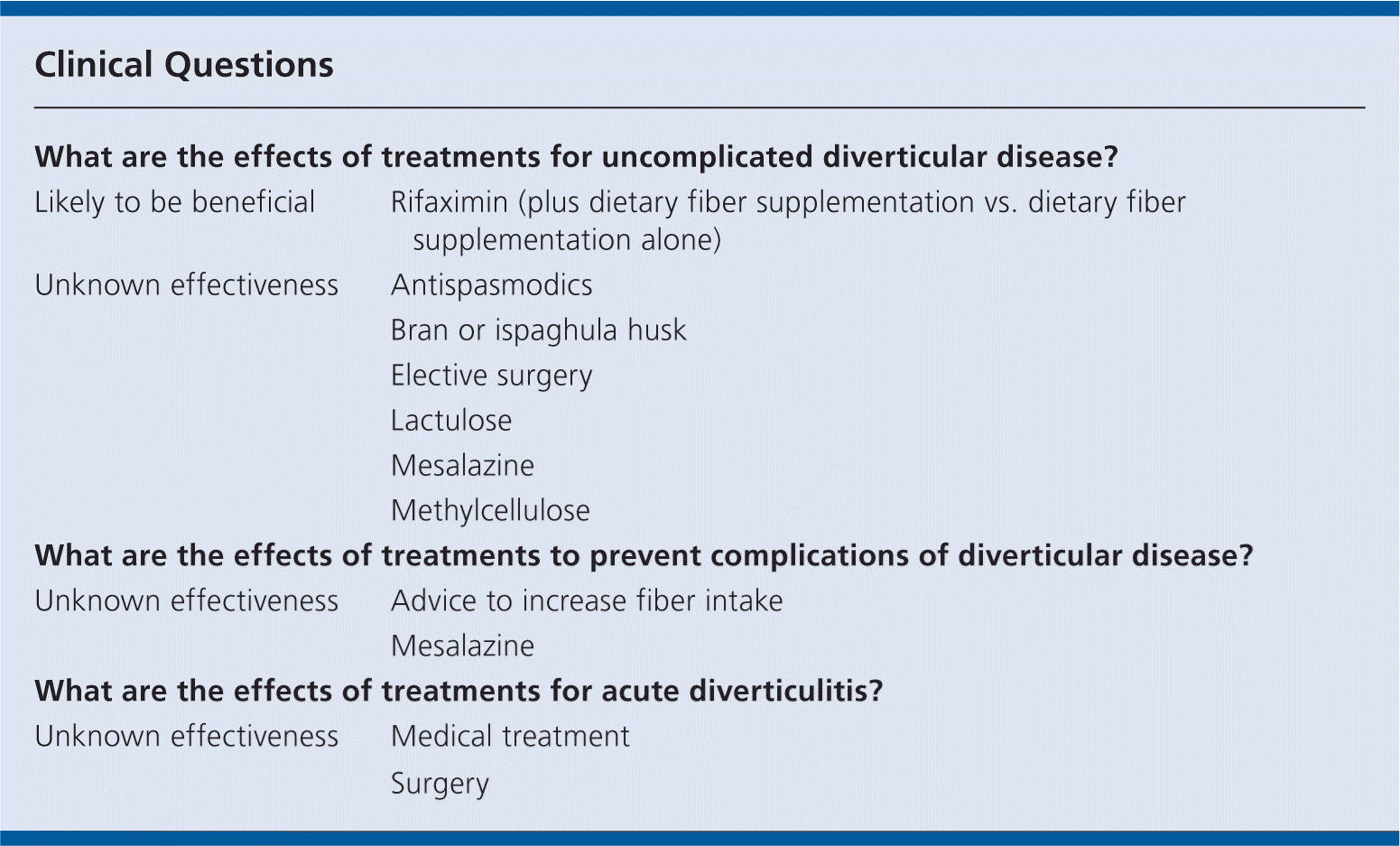
Am Fam Physician. 2011;84(10):1163-1164
Author disclosure: No relevant financial affiliations to disclose.
Diverticula (mucosal outpouching through the wall of the colon) are rare before 40 years of age, after which prevalence increases steadily and reaches greater than 25 percent by 60 years and older. However, only 10 to 25 percent of affected persons will develop symptoms such as lower abdominal pain.
Recurrent symptoms are common, and 5 percent of persons with diverticula eventually develop complications such as perforation, obstruction, hemorrhage, fistulae, or abscesses.
Use of nonsteroidal anti-inflammatory drugs, corticosteroids, and opiate analgesics has been associated with an increased risk of perforation of diverticula, whereas calcium antagonists may protect against these complications.
Dietary fiber supplementation using bran or ispaghula husk and laxatives, such as methylcellulose and lactulose, are widely used to treat uncomplicated diverticular disease, but we do not know whether they reduce symptoms or prevent complications.
Antibiotics (rifaximin) plus dietary fiber supplementation may improve symptoms more than fiber alone, but may increase the risk of adverse effects.
We do not know whether mesalazine is also beneficial at improving symptoms in uncomplicated diverticular disease, or at reducing complications after acute diverticulitis, as no good-quality studies have been found.
We do not know whether elective open or laparoscopic colonic resection improves symptoms in persons with uncomplicated diverticular disease.
Acute diverticulosis is often treated with intravenous fluids, limiting oral intake, and broad-spectrum antibiotics. However, we do not know whether such medical treatment improves symptoms and cure rates in persons with acute diverticulitis.
Surgery is usually performed in persons with peritonitis caused by perforated acute diverticulitis, but we do not know whether it improves outcomes compared with no surgery, or if any one surgical technique is better at preventing complications.

| What are the effects of treatments for uncomplicated diverticular disease? | |
| Likely to be beneficial | Rifaximin (plus dietary fiber supplementation vs. dietary fiber supplementation alone) |
| Unknown effectiveness | Antispasmodics |
| Bran or ispaghula husk | |
| Elective surgery | |
| Lactulose | |
| Mesalazine | |
| Methylcellulose | |
| What are the effects of treatments to prevent complications of diverticular disease? | |
| Unknown effectiveness | Advice to increase fiber intake |
| Mesalazine | |
| What are the effects of treatments for acute diverticulitis? | |
| Unknown effectiveness | Medical treatment |
| Surgery | |
Definition
Colonic diverticula are mucosal outpouchings through the large bowel wall. They are often accompanied by structural changes (elastosis of the taenia coli, muscular thickening, and mucosal folding). They are usually multiple, and occur most often in the sigmoid colon. Most persons with colonic diverticula are asymptomatic, with few findings on clinical examination; however, 20 percent develop symptoms at some point. If diverticula are associated with symptoms, then this is termed diverticular disease. If asymptomatic, then the condition is known as diverticulosis. Persons who go on to develop complications associated with diverticula (inflammation, perforation, fistulae, abscess formation, obstruction, or hemorrhage) are referred to as having complicated diverticular disease. Persons with uncomplicated diverticular disease may report abdominal pain (principally colicky left iliac fossa pain), bloating, and altered bowel habit, and may have mild left iliac fossa tenderness on examination. Acute diverticulitis occurs when a diverticulum becomes acutely inflamed. Persons with acute diverticulitis typically present with severe left iliac fossa pain associated with fever, malaise, and altered bowel habit with left iliac fossa tenderness, associated with general signs of infection, such as fever and tachycardia.
Incidence and Prevalence
In the United Kingdom, the incidence of diverticulosis increases with age; approximately 5 percent of persons are affected in their fifth decade of life, 25 percent at 60 years of age, and approximately 50 percent by their ninth decade. Diverticulosis is common in resource-rich countries, although there is a lower prevalence of diverticulosis in western vegetarians consuming a diet high in fiber. Diverticulosis is almost unknown in rural Africa and Asia.
Etiology and Risk Factors
There is an association between low-fiber diets and diverticulosis of the colon. Prospective observational studies have found that both physical activity and a high-fiber diet are associated with a lower risk of developing diverticular disease. Case-control studies have found an association between perforated diverticular disease and nonsteroidal anti-inflammatory drugs, corticosteroids, and opiate analgesics, and have found that calcium antagonists have a protective effect. Persons in Japan, Singapore, and Thailand develop diverticula that affect mainly the right side of the colon.
Prognosis
Inflammation will develop in 10 to 25 percent of persons with diverticula at some point. It is unclear why some persons develop symptoms and some do not. Even after successful medical treatment of acute diverticulitis, almost two-thirds of persons have recurrent pain in the lower abdomen. Recurrent diverticulitis is observed in 7 to 42 percent of persons with diverticular disease, and after recovery from the initial attack the calculated yearly risk of a further episode is 3 percent. Approximately 50 percent of recurrences occur within one year of the initial episode, and 90 percent occur within five years. Complications of diverticular disease (perforation, obstruction, hemorrhage, and fistula formation) are each seen in approximately 5 percent of persons with colonic diverticula when followed up for 10 to 30 years. In the United Kingdom, the annual incidence of perforation is four cases per 100,000 persons, leading to approximately 2,000 cases annually. Intra-abdominal abscess formation is also a recognized complication.
editor's note: Ispaghula is called psyllium and mesalazine is called mesalamine in the United States.
